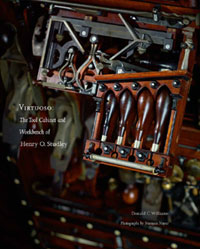
BOOK REVIEW:
Virtuoso -The Tool Cabinet and Workbench of Henry O. Studley
, by Donald C. Williams
by J. Norman Reid
Delaplane, VA
Since
the famous poster
was first published in 1988, the Henry Studley tool cabinet has
occupied iconic status within the woodworking community. The cabinet and its
hundreds of tools have been the subject of many articles and, for a time, a display in the
Smithsonian Institution. It was featured on Norm Abram's
The New Yankee Workshop
.
Its contents have been catalogued and listed. And yet, for all its exposure to the public,
the cabinet and its contents have remained in semi-obscurity. Even more so its creator,
Henry O. Studley.
With the publication of Virtuoso, all this has changed. This latest release from Lost Art
Press combines the research and editorial skills of Don Williams, furniture
conservationist and tool cognoscenti, with the photographic talents of Narayan Nayar.
The result is a complete illustrated documentation of the fabulous cabinet's design and
execution, its tool collection and as much of its and its maker's history as can be
ascertained.
Virtuoso's
eight chapters begin with a description of Williams' first encounter with the
cabinet that represents an homage of sorts to its alluring appeal. A brief visual overview
of the cabinet follows.
Successive chapters detail what little is known about Henry Studley, a highly-skilled
Boston piano maker in an era when richly-detailed decoration adorned high end
instruments intended for finer homes. Only a single photograph of the enigmatic
Studley is known to exist, a newspaper photo of him standing in his workshop, the
famous tool cabinet hanging in the background. When and where Studley built his
cabinet are, frankly, unknown.
More certain is the history and provenance of the cabinet, and the account of its
discovery and rescue from near-certain extinction makes for fascinating, almost
detective story, reading.
The bulk of the book is devoted to a highly-detailed account, richly-illustrated, of the
cabinet's many components, its Masonic symbolism, and the individual tools it was
designed to contain. Built of mahogany, with inlaid ivory, mother-of-pearl, ebony and
other materials, the cabinet is surprisingly compact, given the large array of tools it
holds in layers as much as three deep.
Williams carefully examined and documented each tool in the cabinet, its maker and
marks, its condition and as much as is known about its purpose. Many of the individual
tools were made by Studley himself and reflect the careful detail he lavished on the
cabinet.
Although the cabinet has long been the object of high interest, much less is known
about Studley's workbench, the top of which was rescued from decades of storage in a
Maine barn. It had been separated from its base, now lost, but its present owner, who
prefers anonymity, constructed a replica that appears to be very like the original. Like
the cabinet, the workbench incorporates design elements that set it apart from its
contemporaries in the piano industry, in which this particular workbench style appears to
have predominated.
Williams compares the Studley workbench with other similar benches that have
survived. But he is especially intrigued by the face and tail vises on the bench and
devotes special attention to their design, again comparing their features with similar
vises, none of which bear makers' marks.
Virtuoso concludes with a brief summary of the Studley cabinet's impact on popular
consciousness, a bibliography and index.
Virtuoso is pure celebration of the exquisite craftsmanship and artistry of Henry Studley
and his ingenuity in fitting such a large array of tools into a surprisingly small space.
Anyone who has admired the now iconic poster will find this full exploration of the
cabinet fascinating. Though perhaps few woodworkers will attempt to match Studley's
craftsmanship, his rich design and highly-skilled execution are now more evident than
ever and will inspire more careful design and attention to detail. Collectors will find the
documentation of Studley's 19th century tools useful. And students of American
industrial history will experience enduring interest in this slice of Americana. Virtuoso is
a good read, a feast for the eyes and a collector's item in its own right that will be
greatly appreciated by many.
CLICK HERE to order your copy of
Virtuoso -The Tool Cabinet and Workbench of Henry O. Studley
J. Norman Reid is a woodworker, writer, and woodworking instructor living with his wife in the foothills of the Blue Ridge Mountains with a woodshop full of power and hand tools and four cats who believe they are cabinetmaker's assistants.
He can be reached by email at
nreid@fcc.net
.
Return to
Wood News
front page


